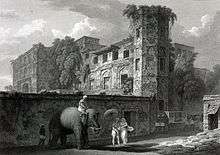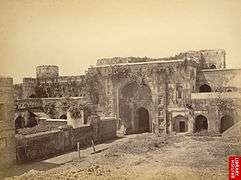Bara Katra

Bara Katra (Bengali: বড় কাটরা) is a historical and architectural monument located in the city of Dhaka, Bangladesh.‘Katra/ katara’ in Arabic and Persian means ‘Caravan (Karwan) Sarai’ or simply a ‘Sarai’. It is a palatial building dating to the reign of the Mughal dynasty in the Bengal region. It is situated to the south of Chowk Bazaar close to the north bank of the river Buriganga.
History
Bara Katra was built between 1644 and 1646 CE to be the official residence of Mughal prince Shah Shuja, the second son of emperor Shah Jahan. The prince endowed it to his diwan and the builder of the serai, Abul Qasim. The word Katra may have originated from Arabic word Katara which means colonnaded building.
Structure

Bara Katra originally enclosed a quadrangular courtyard with 22 rooms on all of its four sides. The ruins consist of an edifice having a river frontage. The southern wing of the structure was planned on a grand scale and was marked with an elaborate three-storeyed gate containing an octagonal central chamber. The remaining portion was two-storeyed and encased by projected octagonal towers.
The gateway structure is lofty in height and projected towards the river. A tall alcove rising to the second storey reduces the mass of this projection. The wall surface is relieved with panels that are square as well as rectangular and that contain a variety of decorations of four-centred, cusped, horseshoe and flat arches. Above the apex of the alcove open the windows of the third storey. Under the alcove is the main arched entrance which leads to the guardroom. Passing through the two successive archways come an octagonal domed hall, the ceiling of which is plastered and bears various net-patterns and foliaged designs. The two-storeyed structure resolves on both sides of the central entrance into a row of five vaulted rooms in the ground floor and living rooms with a continuous corridor on the upper one. The three-storeyed corner towers are hollow and can be approached from the subsidiary structures.
Architecture

The building's architecture follows the traditional pattern of the Central Asia's caravanserai and is embellished as per Mughal architecture. It originally enclosed a quadrangular courtyard surrounded by shops and was overlooked by a row of 22 living cells in each wing. Two gateways were built in the northern and southern wing. The southern wing is a two-storeyed structure and extends 223' along the river. It is marked in the middle by the southern gateway -- an elaborate three storey central archway framed within a projected rectangular bay -- that provides access to the courtyard. The underside of the arched alcove of the gateway is adorned with intricate plasterwork. The wall surface around the spandrels with plastered panels in relief contain a variety of forms such as four-centred, cusped, horse shoe and flat arches. Each wing is two storeyed and the corners are marked by tall octagonal towers.
Internal architecture
-

-

-

-

-
.jpg)
Fac Simile of an Inscription in the Great Kuttra, Dhaka (1825)
Legacy

More than half of the Katra building was destroyed over time owing to neglect. The building remains in a dilapidated condition. The Bangladeshi government has been unable to take charge of the monument owing to litigation and resistance from its present owners. The owners have made several alterations to the original character of the building and have also started construction of a new multi-storeyed building in the area. Urban encroachment and shanty constructions envelop the palace today.
References
- Asher, Catherine B, Inventory of Key Monuments. Art and Archaeology Research Papers: The Islamic Heritage of Bengal (Paris, 1984: UNESCO)
- Ahmed, Nazimuddin, Islamic Heritage of Bangladesh (Dhaka, 1980: Ministry of Information and Broadcasting)
- Hasan, Syed Mahmudul, Muslim Monuments of Bangladesh (Dhaka, 1980: Islamic Foundation)
External links
- Begum, Ayesha (2012). "Bara Katra". In Islam, Sirajul; Jamal, Ahmed A. Banglapedia: National Encyclopedia of Bangladesh (Second ed.). Asiatic Society of Bangladesh.
- Bara Katra architecture
See also
| Wikimedia Commons has media related to Bara Katra. |
Coordinates: 23°42′53″N 90°23′43″E / 23.7146°N 90.3952°E